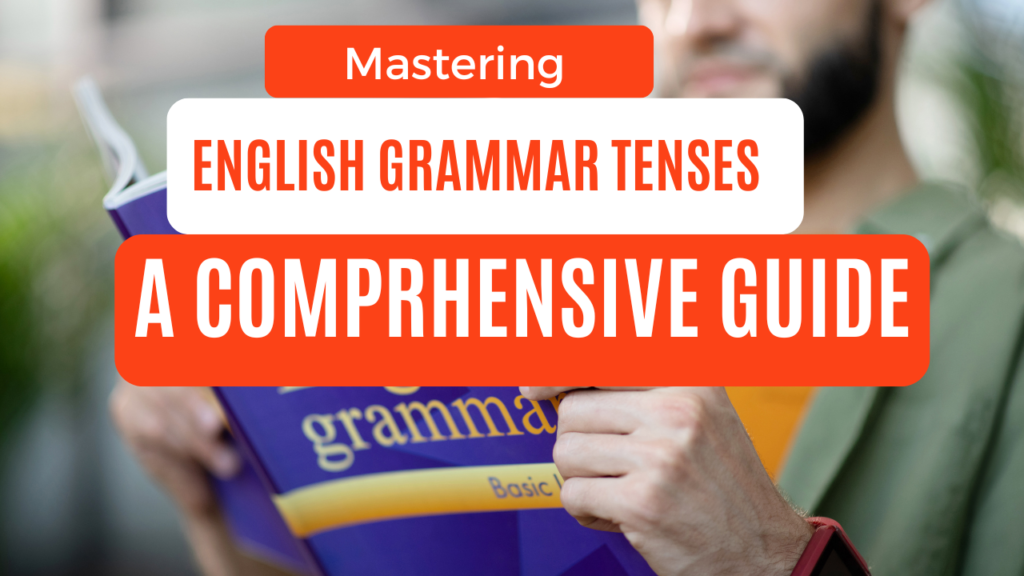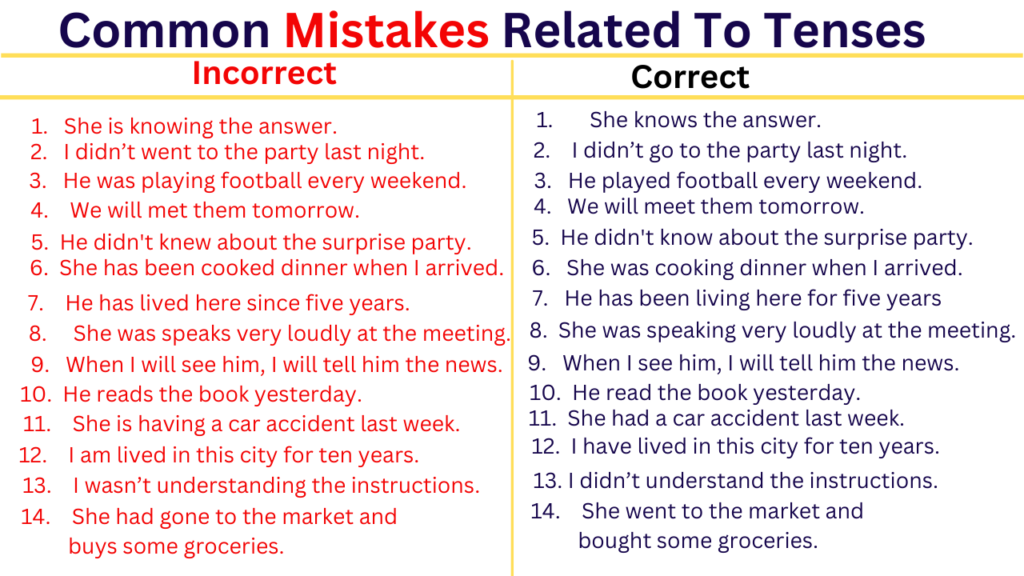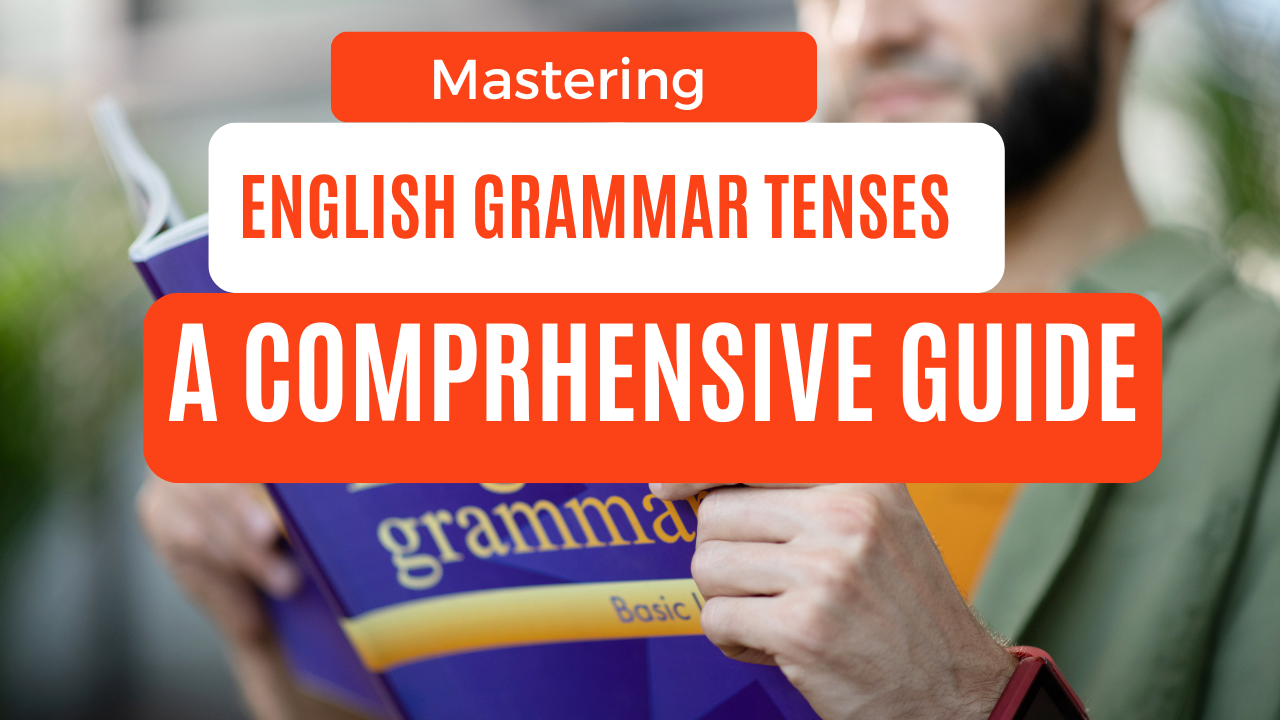English Grammar Tenses Explained: Master Every Tense Easily

Introduction
Tenses are the foundation pillars of English grammar. Whether you are a novice or someone looking to refine your English skills, mastering English grammar tenses is a crucial step in your journey towards fluency. Proper understanding and application of tenses enables you to convey your thoughts clearly and precisely. The ability to use tenses correctly opens doors to many academic and professional opportunities. It, also, boosts your confidence significantly.
In this comprehensive guide, we’ll delve into various aspects of English tenses. We’ll discuss various rules along with examples and tips to improve your grasp on English tenses. We’ll also learn strategies to integrate these tenses seamlessly into your everyday speech and writing. By the end of this post, you’ll gain enough confidence to be able to use English tenses effortlessly.
Why Understanding Tenses is Crucial
With the help of tenses, you can express the time in which an action takes place- present past and future. Knowledge of tenses is vital to get the correct meaning out of any sentence in English. For instance, the difference between “I eat” (present tense) and “I ate” (past tense) can completely change the meaning of your statement.
Incorrect usage of tenses leads to misunderstanding and confusion. In professional life, correct usage of tenses greatly enhances the quality of reports and documents. When one is able to convey thoughts precisely, it fosters credibility and professionalism, potentially leading to career advancement opportunities.
Tenses are also important in storytelling and day-to-day interactions. It can put your thought in correct perspective and timeline, and helps listener understand the context clearly. Effective use of tenses can, therefore, strengthen interpersonal relationships, promote better understanding, and allow meaningful dialogues.
Hence, usage of tenses correctly is a fundamental skill which gets better with regular practice. It enables people present their ideas with confidence and competence.
Understanding the Basic English Grammar Tenses
To be able to use tenses correctly, it is vital to understand the basics of tenses. Tenses basically refer to time and states of action or being. There are three broad categories of tenses.
Present Tense:
It describes actions happening now or regularly.
For instance, in the sentence “She reads books every evening,” the verb ‘reads’ is in the present tense, indicating a habitual action. Another example is “He is studying right now,” where ‘is studying’ shows an ongoing action in the present.
Past Tense:
It describes actions that happened in the past
For example “They visited the museum last week.” Here, ‘visited’ is in the past tense, indicating a completed action. Another example is “She was playing the piano when I arrived,” where ‘was playing’ denotes an action that was ongoing in the past.
Future Tense:
It describes actions that will happen in the future
For example, “We will travel to Japan next year” implies a future action with ‘will travel’ indicating the future tense. Similarly, in the sentence “She is going to start her new job tomorrow,” ‘is going to start’ signifies a planned future action.
Each of these tenses can be further divided into four subcategories:
- Simple Tense: General/regular actions (e.g., “I eat”).
- Continuous Tense: Actions going on (e.g., “I am eating”).
- Perfect Tense: Actions that have completed in a particular time (e.g., “I have eaten”).
- Perfect Continuous Tense: Actions that started in the past and are still continuing (e.g., “I have been eating”).
Step-by-Step Guide to Improving English Grammar Tenses
1. Review and Understand the Rules of Each Tense:
Start by thoroughly reviewing the rules of each tense. Understanding the structure of sentences in each tense is fundamental. Here’s a brief overview:
- Present Simple: Subject + base verb (e.g., “She sings”).
The simple present tense describes habitual actions or general truths. For instance, “She reads a book every evening” or “The sun rises in the east.” Be cautious, as the third-person singular form adds an ‘s’ or ‘es’: “He writes” rather than “He write.”
- Present Continuous: Subject + am/is/are + verb-ing (e.g., “I am reading”).
The present continuous tense tells about actions happening at the moment of speaking or ongoing activities. For example, “They are playing soccer right now” and “She is currently studying for her exams.”
Present Perfect: Subject + have/has + past participle (e.g., “They have finished the work”).
The present perfect tense connects past actions with present. For example, “They have finished their homework already” or “She has lived in New York for five years.” This form is useful to express experiences, changes, and accomplishments.
- Present Perfect Continuous: Subject + have/has + been + verb-ing + time period (e.g., “They have been working on the project for two days”).
The present perfect continuous tense indicates actions that started in the past and continue to the present. Examples are “He has been working on this project since morning” and “They have been learning English for two years.” This form emphasizes the duration and continuity of an action.
- Past Simple: Subject + verb in past form (e.g., “He played”).
The simple past describes actions that happened at a specific time in the past. It often involves regular verbs ending in ‘-ed’ and irregular verbs, which take different forms. For example, “I walked to the market” and “She saw a movie yesterday.” A common mistake learners make- is confusing regular and irregular verbs. It’s important to memorize irregular verb forms to avoid errors.
- Past Continuous: Subject + was/were + verb-ing (e.g., “We were running”).
The past continuous form represents actions that were ongoing in the past. For example, “They were studying all night.” This form is often used to describe the duration of an action in the past time. A frequent error for learners is using the past continuous improperly by omitting ‘was’ or ‘were’. The correct auxiliary verb is important for using this tense.
- Past Perfect: Subject + had + past participle (e.g., “He had left”).
The past perfect expresses actions completed before another action in the past. An example is, “She had finished her homework before dinner.” This form highlights the sequence of past events.
Past Perfect Continuous: Subject + had + been + verb-ing + time period (e.g., “It had been raining for three hours and I got wet.”).
The past perfect continuous tense describes actions that began in the past and continued till another point in the past. It is formed with ‘had been’ plus the present participle. An example is, “He had been working hard before he took a break.” This form indicates the duration and continuity of past actions. A common error involves confusing it with the past continuous; however, the usage of ‘had been’ makes it more clear.
- Future Simple: Subject + will + base verb (e.g., “They will travel”).
The simple future tense is constructed using ‘will’ or ‘shall’ followed by the base form of the verb. It is used for instant decisions, future predictions, and scheduled events. For example, “She will travel to New York next week” conveys a planned trip, while “I will help you with your homework” indicates a sudden decision. A common error here is the misuse of ‘shall’ in American English, where ‘will’ is predominantly preferred.
- Future Continuous: Subject + will be + verb-ing (e.g., “She will be studying”).
- The future continuous tense combines ‘will be’ with the present participle (verb + ing). It describes actions that will be ongoing at a specific future time. An example is, “This time tomorrow, I will be attending a meeting.” It effectively portrays an event in progress in the future. To avoid misuse, ensure the action is continuous and not a one-time event.
- Future Perfect: Subject + will have + past participle (e.g., “I will have completed”).
The future perfect tense uses ‘will have’ followed by the past participle of the verb. It is used for actions that will be completed before a specific future moment. For instance, “By next year, he will have finished his degree.” A frequent mistake is confusing it with the future continuous by ignoring the completion aspect.
Future Perfect Continuous: Subject + will have + been + verb-ing + time period (e.g., “By next year, I will have been studying English for three years.”).
The future perfect continuous uses ‘will have been’ with the present participle. This form indicates actions that will have been ongoing for a duration by a certain future time. For example, “By 2025, they will have been working at the company for a decade.” A common mistake is that the duration is omitted, which is crucial to this tense form’s meaning.
Understanding these basic structures will help you identify and correct errors in your writing and speaking.
2. Practice with Exercises:

Consistent practice is crucial to mastering tenses. Here are some ways to practice:
- Online Quizzes: Many known websites offer free quizzes on tenses.
- Write Sentences: Practice by writing sentences using different tenses. For example, describe your daily routine (present simple), a memorable vacation you had (past simple), and your plans for the weekend (future simple).
- Tense Conversion: Take a paragraph and rewrite it in different tenses. This exercise helps strengthen your knowledge of how tenses change the meaning of sentences.
3. Read Regularly:
The habit of reading regularly exposes you to correct usage of tenses in context. Choose a variety of reading text to explore how tenses are used in different writing styles. While reading, pay attention to how they use different tenses in different contexts.
4. Listen and Imitate:
While listening to other good English speakers, notice the usage of tenses in their speech and try to use tenses the same way. After understanding the usage of tenses from their speech, try using correct tenses naturally in your everyday conversations.
5. Practice Speaking:
Nothing else can be more useful in gaining mastery over tenses than regular practice of speaking. Try using different types of tenses, as per the requirement, in different social contexts. Also, choose such topics where you need to make use of different types of tenses. For instance, your next vacation (future tense) your hobbies (present tense) How you celebrated your last birthday? (past tense).
Example practice exercise:
- Present: “I wake up at 7 AM, have breakfast, and head to work.”
- Past: “Yesterday, I woke up at 7 AM, had breakfast, and headed to work.”
- Future: “Tomorrow, I will wake up at 7 AM, have breakfast, and head to work.”
6. Learn from Mistakes:
It is highly recommended to review your writing or speaking to check if you are using tenses correctly. If you find it difficult to find mistake by yourself, you can take help of some tools like Grammarly which will highlight your tense related error. After knowing the mistake, it is equally important to know why you made that mistake.
For example, if you mistakenly write “He has going” instead of “He is going,” analyze why the present continuous tense was needed and how to correct it.
7. Use Visual Aids

Make a big chart to visually represent all tenses and put it up somewhere where you can see it often. Visual aids like these can help you memorize tenses easily. You can come up with other creative ideas to expose yourself to tenses and their examples more often, in order to master them. Also, you can create a timeline to represent the same action in different tenses.
Example:
- Past: “I had finished my work before dinner.”
- Present: “I am finishing my work now.”
- Future: “I will finish my work by tomorrow.”
Common Mistakes to Avoid:

- Mixing Up Tenses in a Sentence: Don’t change tenses, in a sentence, unless there’s a specific reason to change them.
- Incorrect: “She came to my house but leaves without meeting me.”
- Correct: ” She came to my house but left without meeting me.”
- Incorrect Use of Present Perfect Tense: This tense is often confused with the past simple.
- Incorrect: “I have seen him yesterday.”
- Correct: “I saw him yesterday.”
- Incorrect use of the future tense: Learners often confuse “will” and “going to.” For example, “She will going to the market” instead of “She is going to the market.” To avoid this, remember that “will” generally expresses spontaneous decisions or predictions, whereas “going to” is used for planned actions or events.
- Know when to use continuous tenses versus simple tenses: Some might say, “I’m eating breakfast every morning,” instead of “I eat breakfast every morning.” The present continuous is for current, ongoing actions, while the present simple is for habitual actions.
Conclusion:
Mastering English grammar tenses is crucial for the efficacy of your speaking or writing. By following the techniques and strategies mentioned in this blog post, you can comfortably use tenses, in any situation. Also, regular practice is essential to know your mistakes and be able to switch from one tense to another effortlessly, whenever required.
Include different types of practices, in your daily schedule, to practice tenses. Also, observe how other fluent speakers use tenses effectively, in their speech. Consistent effort will lead to improvement, and soon, using tenses correctly will become second nature. Keep learning, keep practicing, and you’ll see progress!
Want to dive deeper into English grammar?
Grab my ebook : Basic Grammar Rules : Every Learner Must Know – having easy explanations and relevant examples.
Share your thoughts:
Please share your experiences, challenges, and progress in the comments section below. Engaging with others who are also striving to master grammar tenses can provide mutual support and additional insights you may find beneficial. Don’t hesitate to ask questions or provide tips that have helped you improve English grammar.




hello!,I like your writing very much! share we communicate more about your article on AOL? I require an expert on this area to solve my problem. May be that’s you! Looking forward to see you.
Hi! Thanks for your positive feedback.:) You can always connect by sending email to info@sonikabahadur.com
I was reading through some of your articles on this site and I believe this website is really informative ! Keep posting.
Thank you! Will bring more such useful content soon.:)
Thanks for sharing excellent informations. Your website is very cool. I’m impressed by the details that you?¦ve on this site. It reveals how nicely you perceive this subject. Bookmarked this web page, will come back for more articles. You, my pal, ROCK! I found just the information I already searched all over the place and simply couldn’t come across. What an ideal web site.
Thank you for your feedback! Your comments help me bring even better content that can add value. 🙂
Regards! Quite a lot of tips!
casino en ligne
Thank you. Fantastic stuff!
casino en ligne
You said it perfectly..
casino en ligne francais
Wow quite a lot of excellent material!
meilleur casino en ligne
Many thanks! Fantastic information.
casino en ligne fiable
Many thanks, I value this.
meilleur casino en ligne
Cheers! Ample forum posts!
casino en ligne France
Useful material, With thanks!
meilleur casino en ligne
Incredible many of helpful knowledge!
casino en ligne
Excellent stuff, Cheers.
casino en ligne francais
Thank you! Glad that you could get help.
A lot of thanks for every one of your effort on this web site. My mom enjoys engaging in investigation and it’s really easy to see why. My spouse and i hear all about the compelling tactic you deliver rewarding steps through the web site and as well as recommend contribution from other people about this theme plus our girl is in fact studying a whole lot. Enjoy the rest of the year. You are performing a very good job.
Thank you for your lovely comment! Keep reading.
Some truly excellent posts on this website , thanks for contribution.
Thanks for your feedback!
Some genuinely interesting details you have written.Helped me a lot, just what I was searching for : D.
Thank you! I’m glad that you found it helpful.
Its wonderful as your other articles : D, regards for posting.
Thank you so much for your lovely feedback!:)
I love meeting useful information , this post has got me even more info! .
I’m glad to know that my post was helpful. Keep coming back for more!
Heya i am for the primary time here. I found this board and I to find It really helpful & it helped me out a lot. I hope to present one thing back and aid others such as you aided me.
Thank you for your feedback and for such a noble thought! Keep coming back for more. 🙂
This is the right blog for anyone who wants to find out about this topic. You realize so much its almost hard to argue with you (not that I actually would want…HaHa). You definitely put a new spin on a topic thats been written about for years. Great stuff, just great!
Thank you so much! I’m glad that my blog could help you.
I have been checking out a few of your stories and i can claim nice stuff. I will surely bookmark your blog.
Thank you for your feedback!
I believe that is one of the so much vital info for me. And i am satisfied studying your article. However wanna observation on few normal things, The website taste is great, the articles is really great : D. Good process, cheers
Thank you for your feedback!
I do agree with all of the ideas you’ve presented in your post. They’re very convincing and will certainly work. Still, the posts are too short for beginners. Could you please extend them a bit from next time? Thanks for the post.
Sure! Thank you.
There is visibly a bunch to realize about this. I feel you made various good points in features also.
Thank you!
You should take part in a contest for one of the best blogs on the web. I will recommend this site!
That’s really so sweet of you! Will do the same. 🙂
It’s really a nice and helpful piece of information. I am glad that you simply shared this useful information with us. Please stay us up to date like this. Thank you for sharing.
Thank you for your feedback!
Hi! Someone in my Facebook group shared this site with us so I came to check it out. I’m definitely enjoying the information. I’m bookmarking and will be tweeting this to my followers! Superb blog and fantastic design.
Thank you for such a nice gesture! Your feedback made my day. 🙂
Great blog here! Also your site loads up very fast! What web host are you using? Can I get your affiliate link to your host? I wish my website loaded up as fast as yours lol
Thank you for your positive feedback! Here’s my affiliate link https://hostinger.in?REFERRALCODE=W2FSONIKL7B6
There is clearly a bundle to know about this. I consider you made certain good points in features also.
Thank you!
After study a few of the weblog posts in your website now, and I truly like your way of blogging. I bookmarked it to my bookmark website checklist and will probably be checking again soon. Pls take a look at my web site as nicely and let me know what you think.
Thank you for your feedback! Actually, your site was not loading. Will try again later. Keep coming back for more such useful content.
Awsome info and right to the point. I am not sure if this is really the best place to ask but do you people have any thoughts on where to get some professional writers? Thx 🙂
Thank you for your comment! Well, I don’t know any professional writers as I write my own content.
I absolutely love your blog and find the majority of your post’s to be just what I’m looking for. Does one offer guest writers to write content in your case? I wouldn’t mind publishing a post or elaborating on some of the subjects you write related to here. Again, awesome web site!
Thank you for liking my posts! As of now, all posts are written by me only.
Very interesting info !Perfect just what I was looking for!
Glad that you found it useful. Thank you!
It is in point of fact a great and helpful piece of info. I’m glad that you simply shared this useful info with us. Please stay us up to date like this. Thank you for sharing.
I will. Thank you!
Great – I should definitely pronounce, impressed with your web site. I had no trouble navigating through all tabs as well as related information ended up being truly easy to do to access. I recently found what I hoped for before you know it at all. Reasonably unusual. Is likely to appreciate it for those who add forums or something, website theme . a tones way for your client to communicate. Excellent task..
Thank you for your detailed feedback! Helps me understand what can be useful for my dear readers.:)
I’ve been surfing online greater than three hours as of late, yet I never found any interesting article like yours. It¦s lovely price sufficient for me. In my opinion, if all website owners and bloggers made just right content material as you probably did, the web will likely be much more useful than ever before.
I’m in tears to read your comment! Will keep bring useful content even in the future! Keep visiting for more. 🙂
Yay google is my king assisted me to find this outstanding site! .
Thank you for your feedback!
Hey! This post could not be written any better! Reading through this post reminds me of my previous room mate! He always kept chatting about this. I will forward this post to him. Pretty sure he will have a good read. Thanks for sharing!
That’s really very sweet of you! Keep sharing my posts with others. Thank you for your feedback!
I’ve been absent for a while, but now I remember why I used to love this website. Thank you, I?¦ll try and check back more often. How frequently you update your web site?
Thank you for sharing your thoughts! I make changes almost everyday. Keep visiting and keep commenting! 🙂
Oh my goodness! an amazing article dude. Thanks Nevertheless I am experiencing difficulty with ur rss . Don’t know why Unable to subscribe to it. Is there anybody getting similar rss problem? Anyone who is aware of kindly respond. Thnkx
Thank you for your feedback! I’ll try and fix the problem related to rss. Meanwhile, subscribe to the site for receiving regular updates!
Usually I don’t learn post on blogs, but I wish to say that this write-up very pressured me to take a look at and do so! Your writing style has been amazed me. Thanks, very nice post.
Thank you for leaving your feedback! Means a lot.
Usually I do not read post on blogs, but I would like to say that this write-up very forced me to try and do so! Your writing style has been amazed me. Thanks, quite nice post.
Thank you for your feedback!